SLUSCM1A October 2017 – December 2017
PRODUCTION DATA.
- 1 Features
- 2 Applications
- 3 Description
- 4 Revision History
- 5 Description (continued)
- 6 Device Comparison Table
- 7 Pin Configuration and Functions
- 8 Specifications
- 9 Detailed Description
- 10Application and Implementation
- 11Power Supply Recommendations
- 12Layout
- 13Device and Documentation Support
- 14Mechanical, Packaging, and Orderable Information
Package Options
Mechanical Data (Package|Pins)
- RGT|16
Thermal pad, mechanical data (Package|Pins)
- RGT|16
Orderable Information
8 Specifications
8.1 Absolute Maximum Ratings(1)
over the 0°C to 125°C operating free-air temperature range (unless otherwise noted)| MIN | MAX | UNIT | |||
|---|---|---|---|---|---|
| VI | Input Voltage | IN (with respect to VSS) | –0.3 | 28 | V |
| BAT (with respect to VSS) | –0.3 | 5 | V | ||
| OUT, EN1, EN2, CE, TS, ISET, PGOOD, CHG, ILIM, TMR, ITERM, SYSOFF, TD (with respect to VSS) | –0.3 | 7 | V | ||
| II | Input Current | IN | 1.6 | A | |
| IO | Output Current (Continuous) | OUT | 5 | A | |
| BAT (Discharge mode) | 5 | A | |||
| BAT (Charging mode) | 1.5(2) | A | |||
| Output Sink Current | CHG, PGOOD | 15 | mA | ||
| TJ | Junction temperature | –40 | 150 | °C | |
| Tstg | Storage temperature | –65 | 150 | °C | |
(1) Stresses beyond those listed under Absolute Maximum Ratings may cause permanent damage to the device. These are stress ratings only, and functional operation of the device at these or any other conditions beyond those indicated under Recommended Operating Conditions is not implied. Exposure to absolute-maximum-rated conditions for extended periods may affect device reliability. All voltage values are with respect to the network ground terminal unless otherwise noted.
(2) The IC operational charging life is reduced to 20,000 hours, when charging at 1.5A and 125°C. The thermal regulation feature reduces charge current if the IC’s junction temperature reaches 125°C; thus without a good thermal design the maximum programmed charge current may not be reached.
8.2 ESD Ratings
| VALUE | UNIT | |||
|---|---|---|---|---|
| V(ESD) | Electrostatic discharge | Human body model (HBM), per ANSI/ESDA/JEDEC JS-001(1) | ±1500 | V |
| Charged-device model (CDM), per JEDEC specification JESD22-C101(2) | ±500 | |||
(1) JEDEC document JEP155 states that 500-V HBM allows safe manufacturing with a standard ESD control process.
(2) JEDEC document JEP157 states that 250-V CDM allows safe manufacturing with a standard ESD control process.
8.3 Recommended Operating Conditions
| MIN | MAX | UNIT | |||
|---|---|---|---|---|---|
| VI | IN voltage range | 4.35 | 26 | V | |
| IN operating voltage range | 4.35 | 6.4 | V | ||
| IIN | Input current, IN pin | 1.5 | A | ||
| IOUT | Current, OUT pin | 4.5 | A | ||
| IBAT | Current, BAT pin (Discharging) | 4.5 | A | ||
| ICHG | Current, BAT pin (Charging) | 1.5(2) | A | ||
| TJ | Junction Temperature | –40 | 125 | °C | |
| RILIM | Maximum input current programming resistor | 1100 | 8000 | Ω | |
| RISET | Fast-charge current programming resistor (1) | 590 | 8900 | Ω | |
| RITERM | Termination current programming resistor | 0 | 15 | kΩ | |
| RTMR | Timer programming resistor | 18 | 72 | kΩ | |
(1) Use a 1% tolerance resistor for RISET to avoid issues with the RISET short test when using the maximum charge current setting.
(2) The IC operational charging life is reduced to 20,000 hours, when charging at 1.5A and 125°C. The thermal regulation feature reduces charge current if the IC’s junction temperature reaches 125°C; thus without a good thermal design the maximum programmed charge current may not be reached.
8.4 Thermal Information
| THERMAL METRIC(1) | bq2407x | UNIT | |
|---|---|---|---|
| RGT (VQFN) | |||
| 16 PIN | |||
| RθJA | Junction-to-ambient thermal resistance | 44.5 | °C/W |
| RθJC(top) | Junction-to-case (top) thermal resistance | 54.2 | °C/W |
| RθJB | Junction-to-board thermal resistance | 17.2 | °C/W |
| ψJT | Junction-to-top characterization parameter | 1.0 | °C/W |
| ψJB | Junction-to-board characterization parameter | 17.1 | °C/W |
| RθJC(bot) | Junction-to-case (bottom) thermal resistance | 3.8 | °C/W |
(1) For more information about traditional and new thermal metrics, see the Semiconductor and IC Package Thermal Metrics application report.
8.5 Dissipation Ratings
| PACKAGE(2) | RθJA | RθJC | POWER RATING | |
|---|---|---|---|---|
| TA ≤ 25°C | TA = 85°C | |||
| RGT (1) | 39.47°C/W | 2.4°C/W | 2.3 W | 225 mW |
(1) This data is based on using the JEDEC High-K board and the exposed die pad is connected to a Cu pad on the board. The pad is connected to the ground plane by a 2 × 3 via matrix.
(2) For the most current package and ordering information, see the Package Option Addendum at the end of this document, or see the TI website at www.ti.com.
8.6 Electrical Characteristics
Over junction temperature range (0° ≤ TJ ≤ 125°C) and the recommended supply voltage range (unless otherwise noted)| PARAMETER | TEST CONDITIONS | MIN | TYP | MAX | UNIT | ||
|---|---|---|---|---|---|---|---|
| INPUT | |||||||
| UVLO | Undervoltage lock-out | VIN: 0 V → 4 V | 3.2 | 3.3 | 3.4 | V | |
| Vhys | Hysteresis on UVLO | VIN: 4 V → 0 V | 200 | 300 | mV | ||
| VIN(DT) | Input power detection threshold | Input power detected when VIN > VBAT + VIN(DT)
VBAT = 3.6 V, VIN: 3.5 V → 4 V |
55 | 80 | 130 | mV | |
| Vhys | Hysteresis on VIN(DT) | VBAT = 3.6 V, VIN: 4 V → 3.5 V | 20 | mV | |||
| tDGL(PGOOD) | Deglitch time, input power detected status | Time measured from VIN: 0 V → 5 V 1 μs rise-time to PGOOD = LO |
1.2 | ms | |||
| VOVP | Input overvoltage protection threshold | VIN: 5 V → 7 V | 6.4 | 6.6 | 6.8 | V | |
| Vhys | Hysteresis on OVP | VIN: 7 V → 5V | 110 | mV | |||
| tDGL(OVP) | Input overvoltage blanking time (OVP fault deglitch) | 50 | μs | ||||
| tREC | Input overvoltage recovery time | Time measured from VIN: 11 V → 5 V with 1 μs fall-time to PGOOD = LO |
1.2 | ms | |||
| ILIM, ISET SHORT-CIRCUIT DETECTION (CHECKED DURING STARTUP) | |||||||
| ISC | Current source | VIN > UVLO and VIN > VBAT + VIN(DT) | 1.3 | mA | |||
| VSC | VIN > UVLO and VIN > VBAT + VIN(DT) | 520 | mV | ||||
| QUIESCENT CURRENT | |||||||
| IBAT(PDWN) | Sleep current into BAT pin | CE = LO or HI, input power not detected, No load on OUT pin, TJ = 85°C |
4.1 | 7 | μA | ||
| IIN | Standby current into IN pin | EN1= HI, EN2=HI, VIN = 6 V, TJ < 85°C | 39 | 50 | μA | ||
| EN1= HI, EN2=HI, VIN = 10 V, TJ < 85°C | 91 | 200 | |||||
| ICC | Active supply current, IN pin | CE = LO, VIN = 6 V, no load on OUT pin, VBAT > VBAT(REG), (EN1, EN2) ≠ (HI, HI) |
1.5 | mA | |||
| POWER PATH | |||||||
| VDO(IN-OUT) | VIN – VOUT | VIN = 4.3 V, IIN = 1 A, VBAT = 4.2 V | 300 | 475 | mV | ||
| VDO(BAT-OUT) | VBAT – VOUT | IOUT = 1 A, VIN = 0 V, VBAT > 3 V | 50 | 100 | mV | ||
| VO(REG) | OUT pin voltage regulation | VIN > VOUT + VDO(IN-OUT), VBAT < 3.2 V | 3.31 | 3.41 | 3.51 | V | |
| VIN > VOUT + VDO(IN-OUT), VBAT ≥ 3.2 V | VBAT + 145mV | VBAT + 210mV | VBAT + 275mV | ||||
| IINmax | Maximum input current | EN1 = LO, EN2 = LO | 90 | 95 | 100 | mA | |
| EN1 = HI, EN2 = LO | 450 | 475 | 500 | ||||
| EN2 = HI, EN1 = LO | KILIM/RILIM | A | |||||
| KILIM | Maximum input current factor | ILIM = 500 mA to 1.5 A | 1500 | 1610 | 1720 | AΩ | |
| ILIM = 200 mA to 500 mA | 1330 | 1525 | 1720 | ||||
| IINmax | Programmable input current limit range | EN2 = HI, EN1 = LO, RILIM = 8 kΩ to 1.1 kΩ | 200 | 1500 | mA | ||
| VIN-DPM | Input voltage threshold when input current is reduced | EN2 = LO, EN1 = X | 4.35 | 4.5 | 4.63 | V | |
| VDPPM | Output voltage threshold when charging current is reduced | VBAT + 125mV | VBAT + 100mV | VBAT + 85mV | V | ||
| VBSUP1 | Enter battery supplement mode | VBAT = 3.6 V, RILIM = 1.5 kΩ, RLOAD = 10 Ω → 2 Ω | VOUT ≤ VBAT –40mV | V | |||
| VBSUP2 | Exit battery supplement mode | VBAT = 3.6 V, RILIM = 1.5 kΩ, RLOAD = 2 Ω → 10 Ω | VOUT ≥ VBAT–20mV | V | |||
| VO(SC1) | Output short-circuit detection threshold, power-on | VIN > VUVLO and VIN > VBAT + VIN(DT) | 0.8 | 0.9 | 1 | V | |
| VO(SC2) | Output short-circuit detection threshold, supplement mode VBAT – VOUT > VO(SC2) indicates short-circuit | VIN > VUVLO and VIN > VBAT + VIN(DT) | 200 | 250 | 300 | mV | |
| tDGL(SC2) | Deglitch time, supplement mode short circuit | 250 | μs | ||||
| tREC(SC2) | Recovery time, supplement mode short circuit | 60 | ms | ||||
| BATTERY CHARGER | |||||||
| IBAT | Source current for BAT pin short-circuit detection | VBAT = 1.5 V | 4 | 7.5 | 11 | mA | |
| VBAT(SC) | BAT pin short-circuit detection threshold | VBAT rising | 1.6 | 1.8 | 2 | V | |
| VBAT(REG) | Battery charge voltage | ('76) | 4.358 | 4.4 | 4.44 | V | |
| ('78) | 4.31 | 4.35 | 4.39 | ||||
| VLOWV | Pre-charge to fast-charge transition threshold | VIN > VUVLO and VIN > VBAT + VIN(DT) | 2.9 | 3 | 3.1 | V | |
| tDGL1(LOWV) | Deglitch time on pre-charge to fast-charge transition | 25 | ms | ||||
| tDGL2(LOWV) | Deglitch time on fast-charge to pre-charge transition | 25 | ms | ||||
| ICHG | Battery fast charge current range | VBAT(REG) > VBAT > VLOWV, VIN = 5 V CE = LO, EN1 = LO, EN2 = HI |
100 | 1500 | mA | ||
| Battery fast charge current | CE = LO, EN1= LO, EN2 = HI, VBAT > VLOWV, VIN = 5 V, IINmax > ICHG, no load on OUT pin, thermal loop and DPPM loop not active |
KISET/RISET | A | ||||
| KISET | Fast charge current factor | 797 | 890 | 975 | AΩ | ||
| IPRECHG | Pre-charge current | KPRECHG/RISET | A | ||||
| KPRECHG | Pre-charge current factor | 60 | 88 | 118 | AΩ | ||
| ITERM | Termination comparator detection threshold (internally set) | CE = LO, (EN1, EN2) ≠ (LO, LO), VBAT > VRCH, t < tMAXCH, VIN = 5 V, DPPM loop and thermal loop not active |
0.09×ICHG | 0.1×ICHG | 0.11×ICHG | A | |
| CE = LO, (EN1, EN2) = (LO, LO), VBAT > VRCH, t < tMAXCH, VIN = 5 V, DPPM loop and thermal loop not active |
0.027×ICHG | 0.033×ICHG | 0.040×ICHG | ||||
| IBIAS(ITERM) | Current for external termination-setting resistor | VIN > VUVLO and VIN > VBAT + VIN(DT) | 72 | 75 | 78 | μA | |
| tDGL(TERM) | Deglitch time, termination detected | 25 | ms | ||||
| VRCH | Recharge detection threshold | VIN > VUVLO and VIN > VBAT + VIN(DT) | VBAT(REG) –140mV | VBAT(REG) –100mV | VBAT(REG) –60mV | V | |
| tDGL(RCH) | Deglitch time, recharge threshold detected | 62.5 | ms | ||||
| tDGL(NO-IN) | Delay time, input power loss to OUT LDO turn-off | VBAT = 3.6 V. Time measured from VIN: 5 V → 3 V 1 μs fall-time |
20 | ms | |||
| IBAT(DET) | Sink current for battery detection | VBAT = 2.5 V | 5 | 7.5 | 10 | mA | |
| tDET | Battery detection timer | BAT high or low | 250 | ms | |||
| BATTERY CHARGING TIMERS | |||||||
| tPRECHG | Pre-charge safety timer value | TMR = floating | 1440 | 1800 | 2160 | s | |
| tMAXCHG | Charge safety timer value | TMR = floating | 14400 | 18000 | 21600 | s | |
| tPRECHG | Pre-charge safety timer value | 18 kΩ < RTMR < 72 kΩ | RTMR × KTMR | s | |||
| tMAXCHG | Charge safety timer value | 18 kΩ < RTMR < 72 kΩ | 10×R TMR ×KTMR | s | |||
| KTMR | Timer factor | 36 | 48 | 60 | s/kΩ | ||
| BATTERY-PACK NTC MONITOR(1) | |||||||
| INTC | NTC bias current | VIN > UVLO and VIN > VBAT + VIN(DT) | 72 | 75 | 80 | μA | |
| VHOT | High temperature trip point | Battery charging, VTS Falling | 270 | 300 | 330 | mV | |
| VHYS(HOT) | Hysteresis on high trip point | Battery charging, VTS Rising from VHOT | 30 | mV | |||
| VCOLD | Low temperature trip point | Battery charging, VTS Rising | 2000 | 2100 | 2200 | mV | |
| VHYS(COLD) | Hysteresis on low trip point | Battery charging, VTS Falling from VCOLD | 300 | mV | |||
| tDGL(TS) | Deglitch time, pack temperature fault detection | TS fault detected to charger disable | 50 | ms | |||
| VDIS(TS) | TS function disable threshold | TS unconnected | VIN - 200mV | V | |||
| THERMAL REGULATION | |||||||
| TJ(REG) | Temperature regulation limit | 125 | °C | ||||
| TJ(OFF) | Thermal shutdown temperature | TJ Rising | 155 | °C | |||
| TJ(OFF-HYS) | Thermal shutdown hysteresis | 20 | °C | ||||
| LOGIC LEVELS ON EN1, EN2, CE, SYSOFF, TD | |||||||
| VIL | Logic LOW input voltage | 0 | 0.4 | V | |||
| VIH | Logic HIGH input voltage | 1.4 | 6 | V | |||
| IIL | Input sink current | VIL= 0 V | 1 | μA | |||
| IIH | Input source current | VIH= 1.4 V | 10 | μA | |||
| LOGIC LEVELS ON PGOOD, CHG | |||||||
| VOL | Output LOW voltage | ISINK = 5 mA | 0.4 | V | |||
(1) These numbers set trip points of 0°C and 50°C while charging, with 3°C hysteresis on the trip points, with a Vishay Type 2 curve NTC with an R25 of 10 kΩ.
8.7 Typical Characteristics
VIN = 6 V, EN1=1, EN2=0, bq24078 application circuit, TA = 25°C, unless otherwise noted.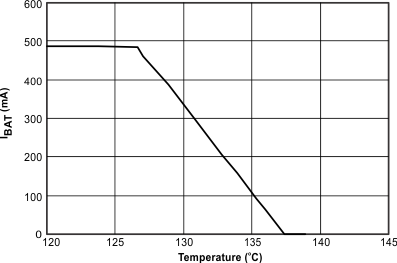
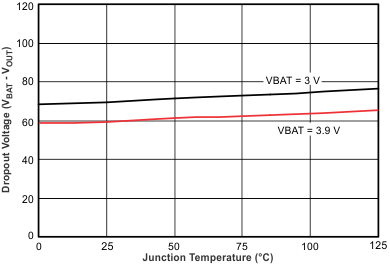
| IL = 1 A | ||
No Input Supply
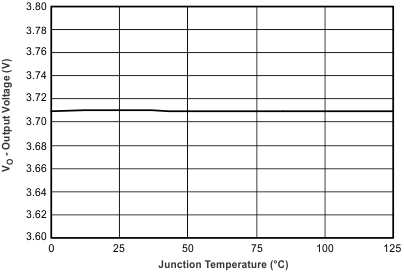
| VIN = 5 V, VBAT = 3.5 V, IL = 1 A | ||
Output Regulation Voltage vs Temperature
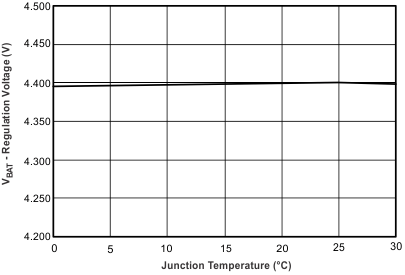
BAT Regulation Voltage vs Temperature
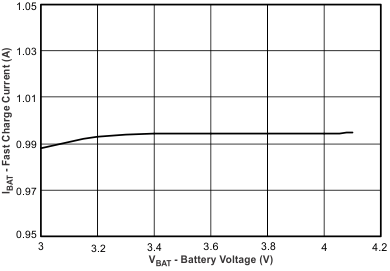
| RISET = 900 Ω | ||
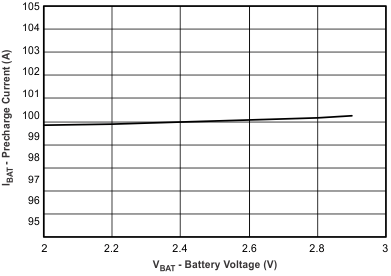
| RISET = 900 Ω | ||
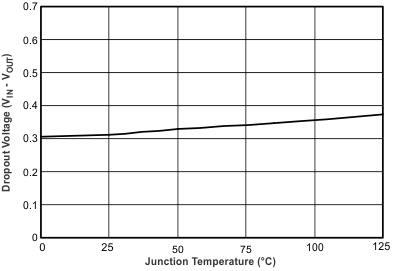
| IL = 1 A | ||
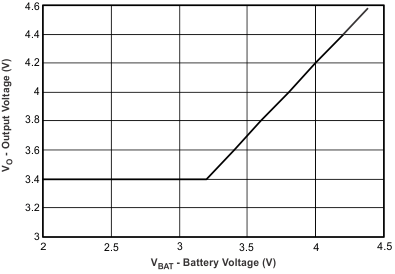
| VIN = 5 V | ||
Output Regulation Voltage vs Battery Voltage
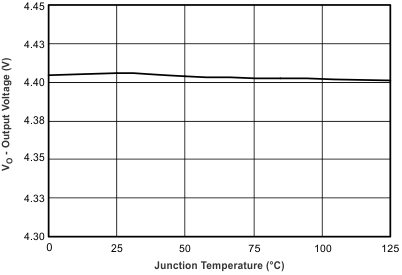
| VIN = 5 V, IL = 1 A | ||
Output Regulation Voltage vs Temperature
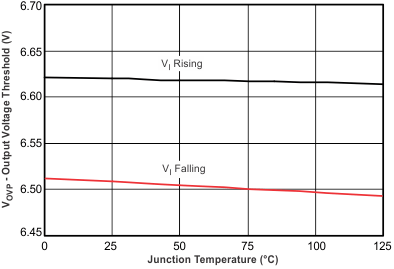
| 6.6 V | ||
Overvoltage Protection Threshold vs Temperature
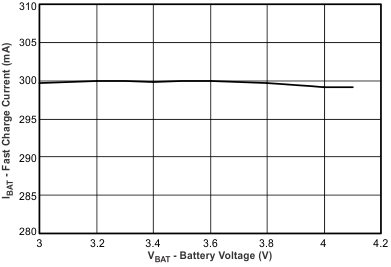
| RISET = 3 kΩ | ||
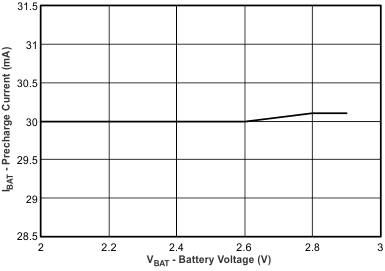
| RISET = 3 kΩ | ||